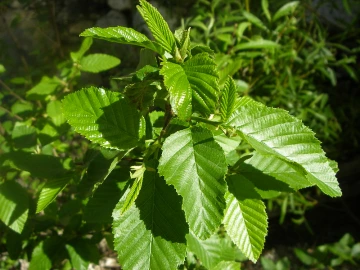
Anthony Mendoza Flickr.com
Botanical Family: Betulaceae
Scientific Name: Alnus oblongifolia
Common Names: Arizona alder
Botanical Description:
Alnus oblongifolia is a large, strongly upright, deciduous tree with a narrow spreading crown, growing up to 30 meters tall at maturity, often with multiple trunks, or occaisionally growing as a large shrub, (1,2,3). The bark is dark gray and smooth, becoming darker in color and breaking into shallow vertical plates with age (1,4). Young branches are slender, and yellow brown in color, with a fine covering of hairs, becoming glabrous with age (4). The 5-9 cm long leaves are simple, narrowly ovate to lanceolate in shape, with densely double-serrate margins, and strong venation, appearing alternately along the stems (1,2,5). The upper side of the leaf is leathery, shiny, and dark green in color, while the lower side is sparsely pubescent, moderately resin-coated, and paler green in color (1,3). Inflorescences form during the winter, with flowers emerging in spring before the leaves (1). Alnus oblongifolia is monoecious, with staminate flowers being 3.5-10 cm long, yellow green catkins that appear in hanging clusters of 3-6 (1,3). Pistillate flowers are 0.6 cm long, reddish green catkins that appear in clusters of 2-7 (1,3). The flowers are wind-pollinated, but sometimes are visited by bees as well (6). After pollination, the pistillate flowers develop into 1-2.5 cm long, woody, ellipsoid infructescences (clusters of fruits) which bear a strong resemble to cones due to their overlapping, paper scales (1,3,4). The infructescence is a conglomerate of irregularly shaped samaras containing many small, winged seeds; it is green at first, but turns a reddish-brown color when ripe (1,3,4).
Ecological Significance:
Arizona alder grows at elevations of 3,000 to 8,000 feet, and is often found in mountain canyons, preferring sandy or rocky stream banks, moist slopes, and riparian zones (1,3). It is only found in scattered populations across high mountain forests in the Southwest (1). Alders (Alnus spp.) are quick growing, even in damaged or burned sites, making them useful in pioneering these types of sites to increase biomass (6). They are known to form an ecologically valuable, symbiotic relationship with nitrogen-fixing actinobacteria Frankia spp., that increases the availability of soil-soluble nitrates utilized by the alder and other nearby plants (6,8,9). The non-overlapping distribution of Arizona alder, which is restricted to isolated mountain ranges in the southwest, is a feature that has been utilized as a tool to study how the variation in composition of Frankia communities relates to host and location (9). The bacteria are found in conjunction with the alder’s roots, forming lobed nodules that may be as large as a human fist (6,8). The spreading root system can prevent or reduce erosion on riverbanks and fallen leaves can greatly enrich compost and soil fertility (6). Some species of butterflies and moths also consume the foliage of Alnus spp. (6).
Ethnobotanical Value:
While little is known about the ethnobotanical uses of Alnus oblongifolia, alders, in general, have been utilized by humans for many purposes, including to manufacture gunpowder and in the smelting of metal ores (6). Alder wood is traditionally used in food preservation and cooking, particularly in the Pacific Northwest for smoking fish and other meat (6). Although bitter and unpleasant in taste, the catkins are edible and high protein (6). Alder bark has a long history of use in dyes and tanning (6). Native Americans have also used the bark of the red alder (Alnus rubra) medicinally to treat dermatitis, poison oak, and insect bites (6). An infusion prepared from the bark has been used to lymphatic disorders and tuberculosis by Blackfeet Native Americans (6). Clinical studies have confirmed that alders contain medically useful triterpenes, betulin and lupeol, which have anti-tumor and anti-inflammatory properties (6,7).
Distribution:
Arizona, New Mexico, Northern Mexico

